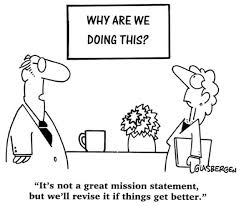Mission Statement: To effectively introduce a Mission statement into a board of directors who cannot see its relevance or day-to-day benefit.
It seems that throughout my Year in Industry this year, the term mission statements has been bounding around a lot. This has often been because I believe that it is fundamental in communicating your objectives to employees, whereas other do not. Looking at mission statements in real life is completely different from looking at them through academic textbooks and papers. Business texts are more often than not, in favour of a Mission or a Vision statement, but in practice, many organisations see it as another fluffy admin task, that the marketing department can create when they’ve finished doing all their colouring in.
But today, I think I found a new meaning and purpose to a mission statement, that all members of an organisation board, can relate to and understand. To me, it was an epiphany moment where I really there really was a metaphorical light bulb above my head.
So lets not think about a mission statement as the first thing you should do when building your future goals and objectives. Lets instead look at the experience that a customer has when they deal with your company. Essentially were talking about customer experience, and this is where your employees come in. What message do your employees convey to customer on a day-to-day basis? What is their tone of voice? Their communication purpose? How can employees improve the customer experience through their day-to-day actions?
The answer to these questions lie within your mission and the way in which you communicate this to your employees. So if we look at the normal way a mission is communicated, you start by telling your employees, who are then supposed to act in accordance with your values to meet this mission. This mission is also communicated to your customers in the way your employees communicate with them. So put simply, it’s a mission, to your employees, to your clients through the way your employees act. But this is often it. This is often the last step of the process and it is then ignored.
Yet when you look at your mission through customer-experience eyes, the closed loop suddenly becomes open. The loop has the potential to become two-way, meaning that your customers can tell you how they want to improve their experiences with you, which can then be reflected by the way your employees act, through the messages you communicate in your mission. Maybe this would be best served using a diagram, I feel like its time:
Closed Loop:
Open loop based on improving Brand experience:
That’s much clearer! An open approach which allows for change and interpretation?
I think by looking at a mission statement through the perspective of improving customer experience, not only are you bringing the customer in to the boardroom, but you are also consciously examining your processes on a continuous basis, interacting with your customers, and giving your employees a greater day-to-day focus. It’s crazy that a mission statement can be seen as fluffy marketing tool, so if your organisation does, then this may just be the way to introduce it to your senior directors and board members. You might even want to call it an open mission statement?
James


